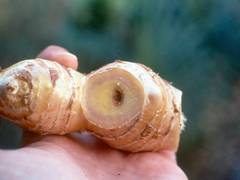-
The infection starts at the collar region of the pseudostems and progresses upwards as well as downwards. The collar region of the affected pseudostem becomes water soaked and the rotting spreads to the rhizome resulting in soft rot.
-
At a later stage root infection is also noticed.
-
Foliar symptoms appear as light yellowing of the tips of lower leaves which gradually spreads to the leaf blades
-
In early stages of the disease, the middle portion of the leaves remain green while the margins become yellow.
-
The yellowing spreads to all leaves of the plant from the lower region upwards and is followed by drooping, withering and drying of pseudostem.
-
Treatment of seed rhizomes with mancozeb 0.3% for 30 minutes before storage and once again before planting reduces the incidence of the disease.
-
Cultural practices such as selection of well drained soils for planting is important for managing the disease, since stagnation of water predisposes the plant to infection.
-
Seed rhizomes are to be selected from disease free gardens, since the disease is also seed borne.
-
Once the disease is located in the field, removal of affected clumps and drenching the affected and surrounding beds with mancozeb 0.3% checks the spread of the disease.

